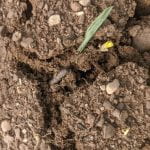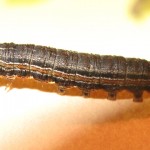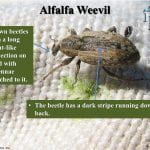NYS IPM Field Crops Pest Report-April 27, 2023
Welcome Back to the Field Crops Pest Report
This spring we are focusing efforts on pheromone trapping black cutworm and true armyworm moths. Black cutworm is an issue every year. True armyworm is an occasional problem but when it occurs it can do a lot of damage to corn, small grains, and grass hay. The reason we monitor for these pests is because they migrate on storms from the south and southwest of NYS. As they migrate, we can trap them weekly and get a good idea what the population might be in specific areas of the state. When an area gets a larger catch of moths puts us on alert to get out and scout in the weeks to come. We can predict by using heat units or degree days when the larvae start to be active in each of the areas with higher populations. While we are just getting started, we have caught some black cutworm moths and a very low population for true armyworm. It is good to start scouting small grains, hay fields and after corn starts to germinate in the next few weeks. The following map is interactive, and you can select the pest and see the populations in your area.
More information on Black Cutworm
https://cals.cornell.edu/field-crops/corn/insects-corn/cutworms
More information on True Armyworm
https://cals.cornell.edu/field-crops/corn/insects-corn/armyworms
Field Crops Pheromone Trap Data Report and Interactive Map
Black Cutworm Degree Day Accumulations from Jan. 1 to May 5
| *Location for Intense Catches |
Black Cutworm (Base 50) |
Life Stage |
| No Intense Catch |
True Armyworm Degree Day Accumulations from Jan. 1 to May 5
| *Location for Intense Catches |
True Armyworm (Base 50) |
Life Stage |
| No Intense Catch |
*Intense Catch is over 15 moths in a week.
Alfalfa Weevil
You might start seeing alfalfa weevils adults in your alfalfa fields. Alfalfa Weevil adults will be laying eggs soon. For more on alfalfa weevil please view the link to management information:
https://cals.cornell.edu/field-crops/forages/insects-forage-crops/alfalfa-weevil
Alfalfa Weevil Degree Day Accumulations from January 1 to April 27.
To better understand or check your area for alfalfa weevil degree days join NEWA . You will need to set up your profile and select the weather stations near you as favorites. Here is a short video on how to create your own profile: Create and Configure Your User Profile Tutorial – direct video download . Next watch this video on how the to check degree days in your area. Tutorial on how to check degree days for alfalfa weevil on NEWA
| Weather Station Location | Alfalfa Weevil | Life Stage |
| Arkport | 152 | Adults are Overwintering |
| Canton | 111 | Adults are Overwintering |
| Ceres | 142 | Adults are Overwintering |
| Corwin | 106 | Adults are Overwintering |
| Geneva | 151 | Adults are Overwintering |
| Highland | 221 | Adults are Overwintering |
| Ithaca | 175 | Adults are Overwintering |
| Kinderhook | 176 | Adults are Overwintering |
| Laurens | 140 | Adults are Overwintering |
| Peru | 109 | Adults are Overwintering |
| Red Hook | 183 | Adults are Overwintering |
| Watertown | 111 | Adults are Overwintering |
Alfalfa Weevil Life stage Development
Growing Degree Days for peak (50%) occurrence of stage
| Stage of Life Cycle | Degree Days * |
| eggs hatch | 280 |
| Instar 1 | 315 |
| Instar 2 | 395 |
| Instar 3 | 470 |
| Instar 4 | 550 |
| Cocooning | 600 |
| Pupa | 725 |
| Adult Emergence | 815 |
*48 degree F base temperature



